The Great Escape (film)
8.6 /10 1 Votes
93% Rotten Tomatoes 4/5 Blu-ray Genre Adventure, Drama, History Duration | 8.3/10 IMDb 4.6/5 Amazon Country United States | |||||||||||||||||||||||||||||||||
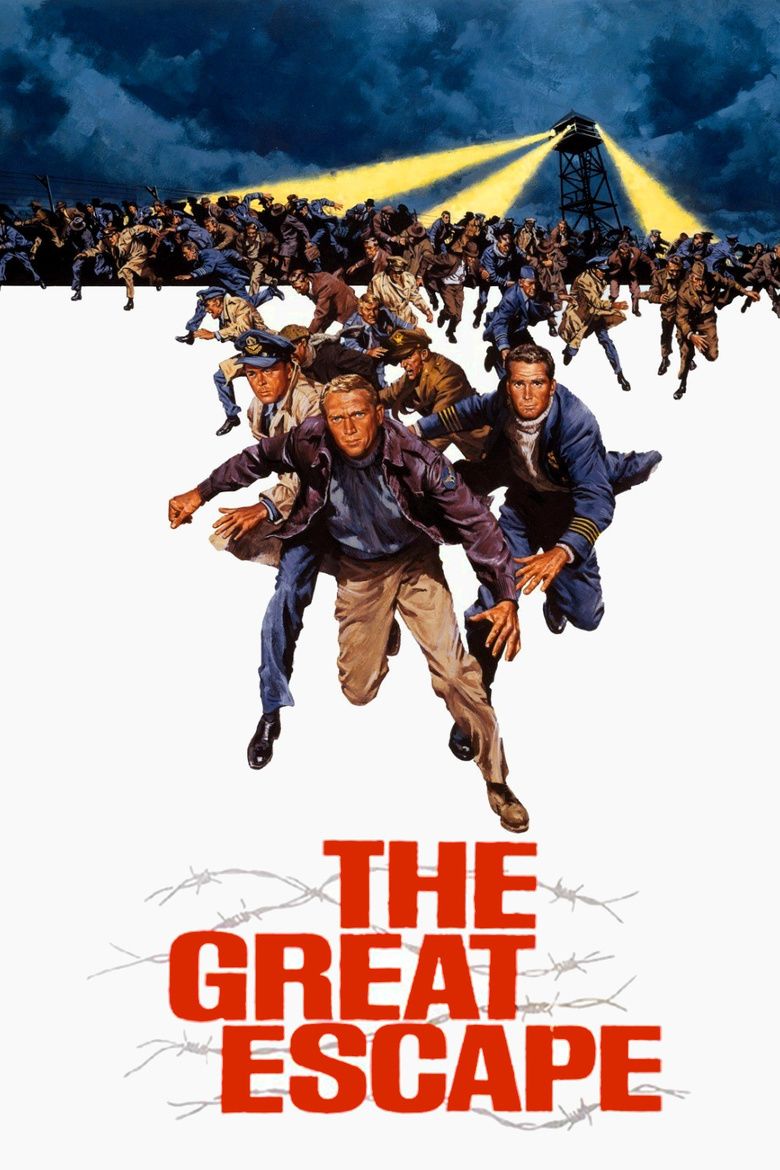 | ||||||||||||||||||||||||||||||||||
Language EnglishGermanFrench Release date June 20, 1963 (1963-06-20) (World Premiere, London)July 4, 1963 (1963-07-04) (US) Cast (Captain Hilts), (Flight Lt. Hendley), (Roger Bartlett), (Group Capt. Ramsey "The SBO"), (Flight Lt. Danny Velinski), (Flight Lt. Colin Blythe "The Forger") Similar movies Max Manus: Man of War , Saving Private Ryan , Schindler's List , Salt , The Pianist , Gandhi Tagline Put a fence in front of these men...and they'll climb it... | ||||||||||||||||||||||||||||||||||
The Great Escape is a 1963 American World War II epic film based on an escape by British Commonwealth prisoners of war from a German POW camp during World War II, starring Steve McQueen, James Garner, and Richard Attenborough, filmed in Panavision.
Contents
- The great escape 1963 original trailer
- Plot
- Adaptation
- Casting
- Location and set design
- Intrada Records album
- Reception
- Awards and honors
- In popular culture
- References
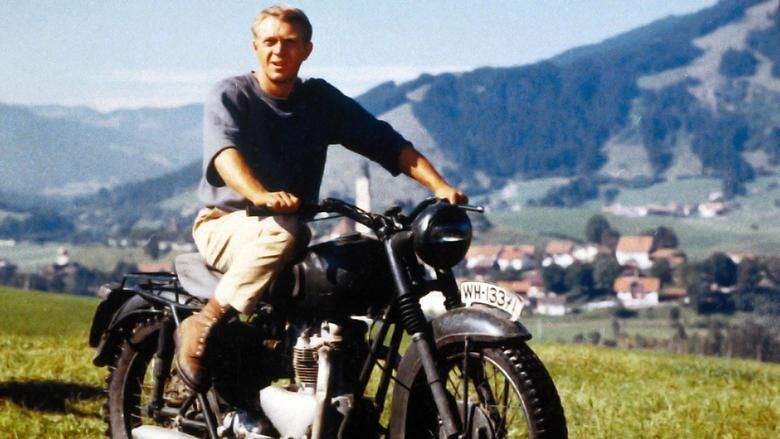
The film is based on Paul Brickhill's 1950 book of the same name, a non-fiction first-hand account of the mass escape from Stalag Luft III in Sagan (now Żagań, Poland), in the province of Lower Silesia, Nazi Germany. The characters are based on real men, and in some cases are composites of several men. However, many details of the actual escape attempt were changed for the film, and the role of American personnel in both the planning and the escape was largely fabricated. The Great Escape was made by the Mirisch Company, released by United Artists, and produced and directed by John Sturges.

The film had its Royal World Premiere at the Odeon Leicester Square in London's West End on 20 June 1963.
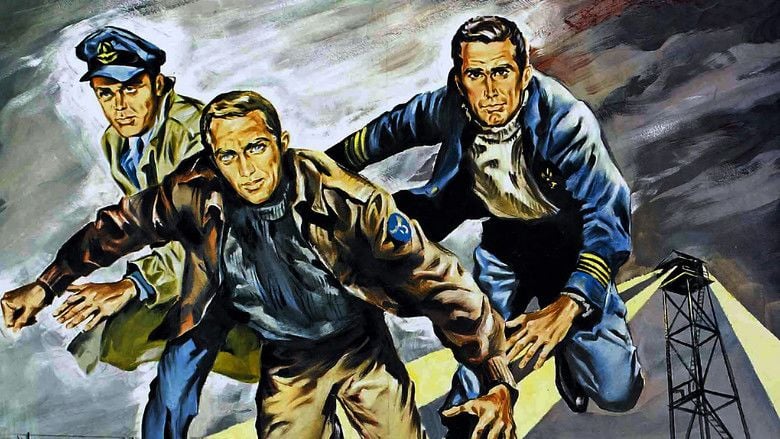
The great escape 1963 original trailer
Plot
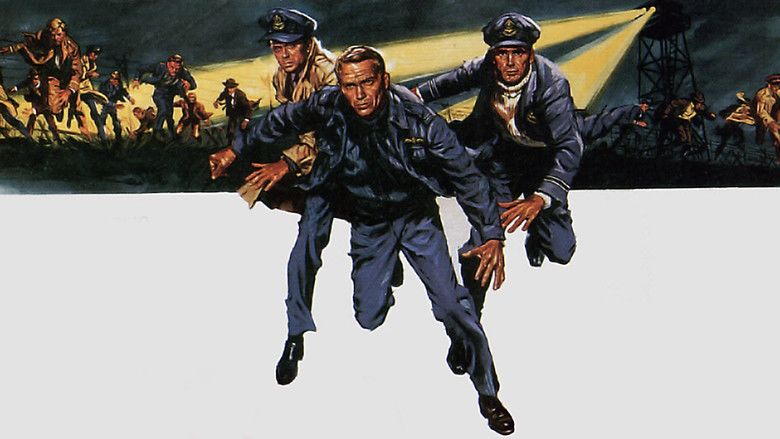
In 1943, having expended enormous resources on recapturing escaped Allied POWs, the Germans move those POWs most determined to escape to a new, high-security prisoner of war camp. The commandant, Luftwaffe Colonel von Luger, tells the senior British officer, Group Captain Ramsey, "There will be no escapes from this camp." Von Luger points out the various features of the new camp designed to prevent escape, as well as the advantages that the prisoners will receive as incentive not to try. After several failed attempts on the first day, the POWs settle into life at the camp.
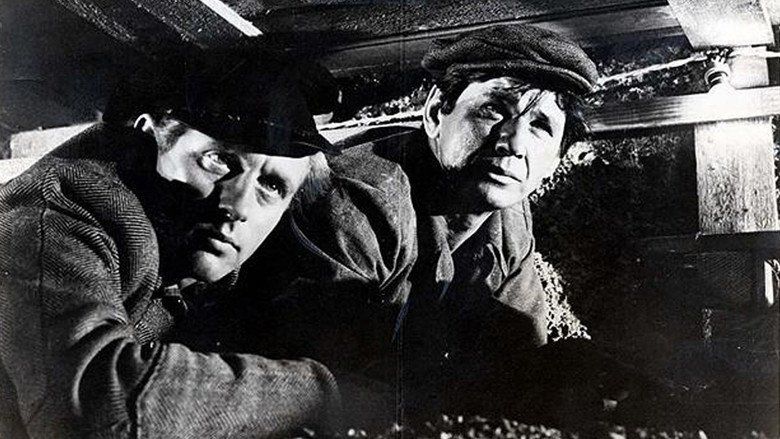
Meanwhile, Gestapo agents Kuhn and Preissen and SS Lieutenant Dietrich bring RAF Squadron Leader Roger Bartlett to the camp. Known as "Big X", Bartlett is introduced as the principal escape organiser. As Kuhn leaves, he warns Bartlett that if he escapes again, he will be shot. However, locked up with "every escape artist in Germany", he immediately plans the greatest escape ever attempted, with tunnels to break out 250 prisoners, so that as many troops and resources as possible will be wasted looking for escapees rather than used at the front line.
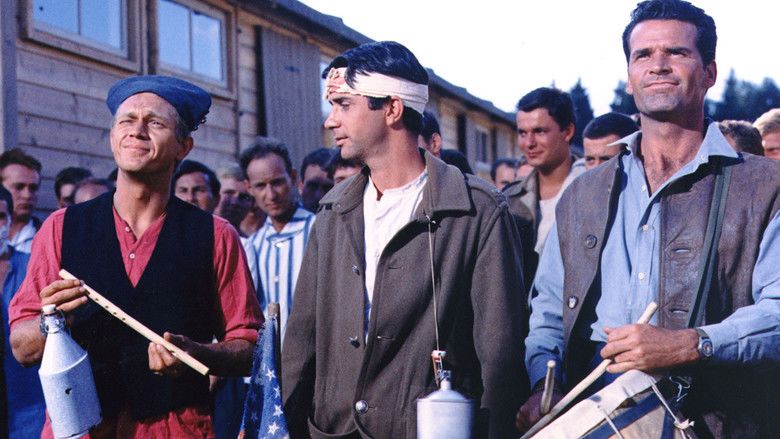
The POWs organise themselves into teams. Flight Lieutenant Robert Hendley is "the scrounger" who finds needed materials, from a camera to clothes and identity cards. Australian Flying Officer Louis Sedgwick, "the manufacturer," makes tools like picks for digging and bellows for pumping air into the tunnels. Flight Lieutenants Danny Valinski and William "Willie" Dickes are "the tunnel kings" in charge of the digging. Flight Lieutenant Andrew MacDonald acts as intelligence provider and Bartlett's second-in-command. Lieutenant Commander Eric Ashley-Pitt of the Royal Navy devises a method of spreading soil from the tunnels over the camp, under the guards' noses. Flight Lieutenant Griffith acts as "the tailor", creating civilian outfits from scavenged cloth. Forgery is handled by Flight Lieutenant Colin Blythe, who becomes nearly blind due to progressive myopia caused by intricate work by candlelight; Hendley takes it upon himself to be Blythe's guide in the escape. The prisoners work on three tunnels simultaneously, calling them "Tom", "Dick", and "Harry".

USAAF Captain Virgil Hilts, the "Cooler King", irritates guards with frequent escape attempts and general irreverence. Hilts and RAF Flying Officer Archibald Ives conceive an escape attempt through a short tunnel at a blind spot right near the edge of the camp, a proposal which is accepted by Bartlett on the grounds that vetoing every independent escape attempt would raise suspicion of the collective escape attempt being planned. However, Hilts and Ives are caught and returned to the 'cooler'. Upon release from the cooler, Bartlett requests that Hilts use his next escape attempt as an opportunity for a reconnaissance of the area immediately surrounding the camp; Hilts turns down Bartlett's request but assists the prisoners as a scrounger. Meanwhile, Hendley forms a friendship with German guard Werner, which he exploits to obtain documents, and then as blackmail to get hold of other items for the escape. Soon, Bartlett orders "Dick" and "Harry" to be shut down, as "Tom" is closest to completion.

While the POWs enjoy a 4th of July celebration arranged by the three Americans, the guards discover "Tom". The mood drops to despair and Ives, who has been badly affected by his time in the cooler, walks in a daze to the barbed wire that surrounds the camp and climbs it in view of guards; Hilts runs to stop him but is too late, and Ives is shot dead near the top of the fence. The prisoners switch their efforts to "Harry", and Hilts agrees to reconnoiter outside the camp and allow himself to be recaptured. The information he brings back is used to create maps to guide the escapees.
The last part of the tunnel is completed on the scheduled night, but it proves to be twenty feet short of the woods. Knowing there are no other options, Bartlett orders the escape to go ahead, and Hilts improvises a signal system to allow them to exit the tunnel between sweeps of the guards on patrol. The claustrophobic Danny, having spent much of his time in the tunnel and barely surviving multiple cave-ins, nearly refuses to go, but is helped along by Willie. 76 prisoners manage to escape: however, Griffith impatiently exits the tunnel in view of the guards and the escape is discovered.
After attempts to reach neutral Switzerland, Sweden, or Spain, almost all the POWs are recaptured or killed. Hendley and Blythe steal a plane to fly over the Swiss border, but the engine fails and they crash-land. Soldiers arrive and Blythe, his eyesight damaged, stands and is shot. Hendley surrenders as Blythe dies.
When Bartlett is identified in a crowded railway station by Gestapo agent Kuhn, Ashley-Pitt overpowers and shoots him with his own gun, but is killed by soldiers while attempting to escape. The resulting confusion allows Bartlett and MacDonald to slip away, but they are later caught while boarding a bus after MacDonald blunders by replying to a suspicious Gestapo agent who wishes them "Good luck" in English. MacDonald is quickly apprehended, but Bartlett manages to temporarily escape, until he is recognised and arrested by SS Lieutenant Steinach. Hilts steals a motorcycle and is pursued by German soldiers, jumps a first-line barbed wire fence at the German-Swiss border and drives on to the Neutral Zone, but becomes entangled in the second line of the barbed fence and is captured.
Three truckloads of recaptured POWs are driven down a country road and split off in three directions. One truck, containing Bartlett, MacDonald, Cavendish, Haynes, and others, stops in a field and the POWs are told to get out and "stretch their legs". They are shot dead under the pretense that they were trying to escape. In all, 50 escapees are murdered; Hendley and ten others are returned to the camp. Von Luger is relieved of command of the camp by SS Lieutenant Steinach for having failed to prevent the breakout. It is heavily implied that he will be executed.
Only three POWs make it to safety: Danny and Willie steal a rowboat and proceed downriver to the Baltic coast, where they sneak aboard a Swedish merchant ship, while Sedgwick slips through the countryside on a stolen bicycle before hiding aboard a freight train to France, where he is guided by the Resistance into Spain. Hilts is returned to the camp alone in handcuffs and taken back to the cooler – ironically just as Von Luger is relieved of his command. Lieutenant Goff, one of the Americans, fetches Hilts's baseball and glove and throws them to him when Hilts and his guards pass by. The guard locks him in his cell and walks away, but momentarily pauses when he hears the familiar sound of Hilts bouncing his baseball against a cell wall.
Adaptation
The story was adapted by James Clavell, W. R. Burnett, and Walter Newman from Paul Brickhill's book The Great Escape. Brickhill had been a prisoner at Stalag Luft III during World War II.
The film was to a significant extent fictional, based on real events but with numerous changes made to increase its drama and appeal, and as a vehicle for its box-office stars. While some of its characters were fictitious, most were amalgams of several real characters and others based on real people. In reality there were no escapes by aircraft or motorcycle: the motorcycle sequence was asked for by McQueen, a keen motorcyclist, who did the stunt riding himself (except for the final jump, done by Bud Ekins). Nor were the recaptured prisoners executed at the same time. The screenwriters significantly increased the involvement of American POWs; the real escape was by largely British and other allied personnel. A few American officers in the camp initially helped dig the tunnels, and worked on the early plans; however, they were moved away seven months before the escape, ending their involvement. In addition, the film suggests the three prisoners who escaped to freedom were British, Polish, and Australian; in reality, they were Norwegian (Jens Müller and Per Bergsland) and Dutch (Bram van der Stok).
The film omits to mention the crucial role Canadians played in building the tunnels and in the escape itself. Of the 1,800 or so POWs, 600 were involved in preparations out of which 150 were Canadian. Wally Floody, an RCAF pilot and mining engineer who was the real-life "tunnel king", was engaged as a technical advisor for the film.
Ex-POWs asked film-makers to exclude details about the help they received from their home countries, such as maps, papers, and tools hidden in gift packages, lest it jeopardise future POW escapes. The film-makers complied.
Casting
Steve McQueen, in a role based on at least three pilots, David M. Jones, John Dortch Lewis, and William Ash, has been credited with the most significant performance. Critic Leonard Maltin wrote that "the large, international cast is superb, but the standout is McQueen; it's easy to see why this cemented his status as a superstar." McQueen served in the US Marines after WWII, and is credited for saving fellow Marines' lives during an Arctic exercise.
Richard Attenborough was cast as Sqn Ldr Roger Bartlett RAF ("Big X"), a character based on Roger Bushell, the South African-born British POW who was the mastermind of the real Great Escape. This was the film that first brought Attenborough to wide popular attention in the United States. During the Second World War, Attenborough served in the Royal Air Force. He volunteered to fly with the Film Unit and after further training, where he sustained permanent ear damage, qualified as a sergeant, flying on several missions over Europe filming from the rear gunner's position to record the outcome of Bomber Command sorties.
Group Captain Ramsey RAF (the "SBO") was based on Group Captain Herbert Massey, a WWI veteran who had volunteered in WWII. He is played by James Donald. Massey walked with a limp, and so did Ramsey in the movie who walked with a cane. Massey had suffered severe wounds to the same leg in both wars. There would be no escape for him but as Senior British Officer, he had to know what was going on. Group Captain Massey had been a veteran escaper himself and had been in trouble with the Gestapo. His experience allowed him to offer sound advice to the X-Organisation. Another officer that had most likely inspired the character of Ramsey was Wing Commander Harry Day. There was an uncanny resemblance between Harry Day and James Donald as Group Captain Ramsey in this picture.
Flt Lt Colin Blythe RAF ("The Forger") was based on Tim Walenn and played by Donald Pleasence. Pleasence himself had served in the Royal Air Force during World War II. He was shot down and spent a year in German prisoner-of-war camp Stalag Luft I.
Charles Bronson had been a gunner in the USAAF and was wounded, but had not been shot down. Like his character, Danny Valinski, he was a coal miner and suffered from claustrophobia.
James Garner had been a soldier in the Korean War and was twice wounded. He was a scrounger during that time, as is his character Flt Lt Hendley.
Hannes Messemer was cast as the Kommandant of Stalag Luft III, "Colonel von Luger," a character based on Oberst Friedrich Wilhelm von Lindeiner-Wildau. He had been a POW in Russia during World War II and had escaped by walking hundreds of miles to the German border.
Angus Lennie's Flying Officer Archibald Ives, "The Mole", was based on Jimmy Kiddel, who was shot dead while trying to scale the fence.
The film is accurate in showing that only three escapees made home runs, although the people who made them differed from those in the film. The escape of Danny and Willie in the film is based on two Norwegians who escaped by boat to Sweden, Per Bergsland and Jens Müller. The successful escape of James Coburn's Australian character Sedgwick (the manufacturer) via Spain was based on Dutchman Bram van der Stok. Coburn, an American, was cast in the role of Royal Australian Air Force (RAAF) Flying Officer Louis Sedgwick who was an amalgamation of Flt Lt Albert Hake, an Australian serving in the RAF and the camps compass maker, and Johnny Travis, the real manufacturer.
Tilman 'Til Kiwe' Kiver played the German guard "Frick". He is the one who fires his pistol at Steve McQueen's character during the escape. Kiwe had been a German paratrooper officer who was captured and held prisoner at a POW camp in Colorado. He made several escape attempts, dyeing his uniform and carrying forged papers. He was captured in the St. Louis train station during one escape attempt. He won the Knight's Cross before his capture and was the cast member who had actually done many of the exploits shown in the film.
Location and set design
The film was made at the Bavaria Film Studio in the Munich suburb of Geiselgasteig in rural Bavaria, where sets for the barrack interiors and tunnels were constructed. The camp was built in a clearing of the Perlacher forest near the studio. The German town near the real camp was Sagan (now Żagań, Poland); it was renamed Neustadt in the film. Many scenes were filmed in and around the town of Füssen in Bavaria, including its railway station. The nearby district of Pfronten with its distinctive St. Nikolaus Church and scenic background also features often in the film. Many scenes involving the railway were filmed near Deisenhofen station and on the Großhesselohe - Holzkirchen line. The castle Hendley and Blythe fly by while attempting to escape is Neuschwanstein Castle.
The film depicts the tunnel codenamed Tom as having its entrance under a stove and Harry's as in a drain sump in a washroom. In reality, Dick's entrance was the drain sump, Harry's was under the stove, and Tom's was in a darkened corner next to a stove chimney.
The motorcycle chase scenes with the barbed wire fences were shot on meadows outside Füssen, and the "barbed wire" that Hilts crashes into before being recaptured was simulated by strips of rubber tied around barbless wire, constructed by the cast and crew in their spare time. The final jump scene was performed by stuntman Bud Ekins in place of Steve McQueen. Other parts of the chase were done by McQueen, playing both Hilts and the soldiers chasing him, because of his ability on a motorcycle.
Intrada Records album
Disc one
Disc two
Disc three
Reception
The Great Escape grossed $11.7 million at the box office, after a budget of $4 million. It became one of the highest-grossing films of 1963, despite heavy competition. In the years since its release, its audience has broadened, cementing its status as a cinema classic. It was entered into the 3rd Moscow International Film Festival where McQueen won the Silver Prize for Best Actor.
Critical and public response has mostly been enthusiastic, with a 93% rating on Rotten Tomatoes. In 1963 New York Times critic Bosley Crowther wrote: "But for much longer than is artful or essential, The Great Escape grinds out its tormenting story without a peek beneath the surface of any man, without a real sense of human involvement. It's a strictly mechanical adventure with make-believe men." British film critic Leslie Halliwell described it as "pretty good but overlong POW adventure with a tragic ending". In Time magazine 1963: "The use of color photography is unnecessary and jarring, but little else is wrong with this film. With accurate casting, a swift screenplay, and authentic German settings, Producer-Director John Sturges has created classic cinema of action. There is no sermonizing, no soul probing, no sex. The Great Escape is simply great escapism".
In a 2006 poll in the United Kingdom, regarding the family film that television viewers would most want to see on Christmas Day, The Great Escape came in third, and was first among the choices of male viewers.
In 2009, seven POWs returned to Stalag Luft III for the 65th anniversary of the escape and watched the film. According to the veterans, many details of the first half depicting life in the camp were authentic, e.g. the machine-gunning of Ives, who snaps and tries to scale the fence, and the actual digging of the tunnels. In 2014, the RAF staged a commemoration of the escape attempt, with 50 serving personnel carrying a photograph of one of the men shot.
Awards and honors
In popular culture
References to scenes and motifs from the film, as well as Elmer Bernstein's theme, have appeared in other films, television series, and video games.
References
The Great Escape (film) WikipediaThe Great Escape (film) IMDbThe Great Escape (film) Rotten TomatoesThe Great Escape (film) Amazon.comThe Great Escape (film) Blu-ray.comThe Great Escape (film) themoviedb.org
